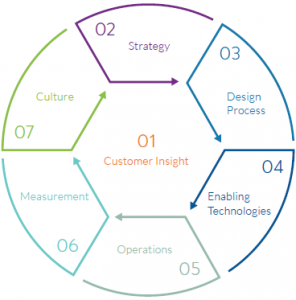The previous 12 posts in this series have taken us on quite a journey. We started by defining the term “customer” in the context of pharma and med device, discussed why “customer” and “customer experience” (CX) matter in life sciences, and rounded it out by walking through each of the seven dimensions of CX maturity represented in the diagram below.
Today’s post is a recap of the most important takeaways from the series, as well as a library of links to the individual posts and to additional relevant resources.
Key Takeaways
- You have customers. They are patients, physicians, clinical site personnel, clinical investigators, clinical subjects, CRO partners, regulatory agencies, and even your employees. Think: Any group of people that you interact with and want to think/feel/behave in a particular way toward your organization.
- Your customers care about customer experience (CX). The same people who shop on Amazon also take your medications, rely on your medical devices, prescribe your medications, partner with you on research, review your regulatory applications and reports, and sit next to you at the office.
- The sooner you embrace #1 and #2, the better. Having a stellar CX is key to customer loyalty on all fronts, not just for patients and treating physicians. If you want to attract and retain the best funders, the best CRO partners, the best investigators, and the best employees in the industry, you need to provide a consistently outstanding CX. When companies prioritize CX, they generate 60% higher profits than their competitors. Retention is a key indicator of great CX, and a 10% increase in customer retention yields a 30% increase in the value of the company. A 5% increase in customer retention can increase profits by 25-125%. (sources cited in Perficient Digital’s CX strategy guide)
- CX is not just a marketing function. In order to excel in CX, your entire business needs to be aligned. CX as a strategy depends on ongoing, top-down, company-wide commitment to creating, delivering, and sustaining the experiences that matter to your customers.
- Outstanding CX requires excellence across seven dimensions. These are: Customer Insight, Strategy, Design Process, Enabling Technologies, Operations, Measurement, and Culture. Customer Insight is at the heart of the other six, as it is the most critical component.
Posts in this Series
- Applying The Concept Of Customer Experience (CX) To Life Sciences
- Life Sciences Is Not Immune To The Age Of The Customer
- The Marriage Of Life Sciences And Retail
- How Great CX Drastically Increases Revenue, Even In Life Sciences
- 7 Dimensions Of An Effective Customer Experience (CX) Strategy
- Customer Experience Dimension #1: Customer Insight
- Customer Experience Dimension #2: Strategy
- Customer Experience Dimension #3: Design Process
- Customer Experience Dimension #4: Enabling Technologies
- Customer Experience Dimension #5: Operations
- Customer Experience Dimension #6: Measurement
- Customer Experience Dimension #7: Culture
Additional Resources
- Life Sciences is Going Digital: 30 Examples from Industry Leaders | Download
- Modernizing Clinical Trial Operations with Digital Experience Technologies | Download
- A Proven Methodology for Improving Clinical Site Performance | Download
- How to Automate Clinical, Safety, and Business Processes with Innovative Technology | Watch
- Incorporating Digital Technology into Clinical Trials | Watch
- Cultivating Pharma-Patient Relationships in the Digital Era | Watch
- Transforming How Sponsor and CROs Interact with Clinical Sites | Watch
- Keeping Clinical Investigators Happy, Productive, and Loyal | Watch
To those of you who have been with me throughout the series, thank you! It’s been a blast being your tour guide and I hope we get to work together in person sometime down the road.
Now, go forth and knock the socks off ALL of your customers!


